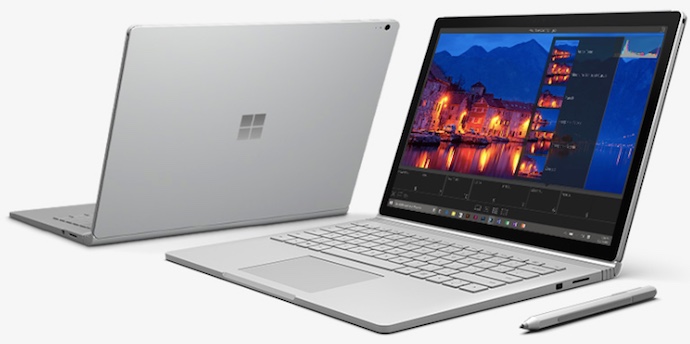
Increasingly, I’ve become a fan of 2-in-1 (or convertible) laptops. The form factor makes a lot of sense, offering the traditional advantages of the clamshell laptop we’re all familiar with but adding the versatility of being able to be used as a tablet. They’re lightweight, offer excellent battery life and for many people, one of these means no need to invest in (or lug around) two separate devices. I posted about the reasons why a 2-in-1 should be on the radar of anyone looking for a new laptop a few months ago, but with the introduction of the new Microsoft Surface Book, the case for these devices just got even stronger.
|
Microsoft Surface Book Key Specs
|
I like the Surface Pro and Surface line, but they aren’t perfect. When used as a tablet, they’re great. Equip one with the optional Surface Type Cover and they make a pretty decent laptop alternative, at least for casual use or if you’re willing to keep them on a table. My problem is that the Type Cover can be a little flexible and while the kickstand does a good job of keeping the whole thing steady on a flat surface, when trying to use a Surface as a true laptop (on your lap), the picture isn’t quite as pretty.
Besides which, good as the Type Cover is, there’s not a whole lot of key travel, so the typing experience is usually better on a traditional laptop—at least if you have an extended period of typing ahead.
What it boils down to is that the Surface Pro and Surface are 2-in-1s, but they’re weighted a bit more toward the tablet side of things than the laptop side. I think Microsoft acknowledges this when they make the Type Cover optional instead of including it as part of the package.
Surface Book: True 2-in1 Laptop, Weighted More to the Laptop Side of Things
Microsoft caught many people off guard today with the introduction of the new Surface Book. It has the “Surface” name and it’s also a 2-in-1, but this new hardware is clearly a laptop first and foremost. It marks a new milestone for Microsoft, the first time that it’s gone outside of traditional PC hardware partners to design and build its own laptop.
While the Surface tablets have an optional keyboard accessory, The Surface Book is a full-fledged laptop with a full-sized, backlit keyboard and glass trackpad, a full array of input and output ports and serious horsepower under the hood. It comes equipped with Intel’s 6th generation Skylake chips (with the choice of a Core i5 or Core i7 CPU). A full 8GB of RAM is standard and it can be loaded up with up to 16GB. Storage is also generous with a 128GB SSD in the base model and the option of expanding up to 512GB.
There’s also the option to add a discrete, Nvidia video card to ramp up graphics performance even further, putting this laptop in an elite group that allows such upgrades.

The high resolution (3000 x 2000 pixels) display has 10-point multi-touch capability to take full advantage of Windows touch gestures and supports an included Surface Pen stylus. The display is cleverly hinged so it can be twisted to face backwards (for presentations, watching a video or scribbling a note), but when you want a tablet, it completely detaches from the base at the push of a button. Now you have a 728g, 7.7mm thin, 13.5-inch Windows tablet with over 6 million pixels.
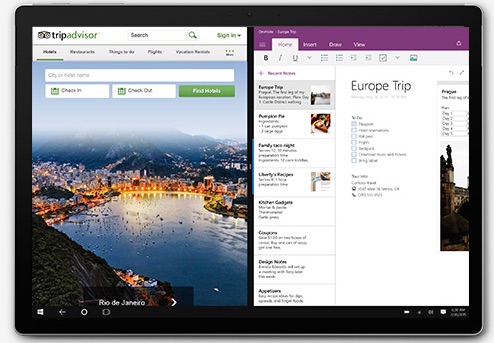
Microsoft designed that display with a 3:2 aspect ratio, which is unusual for a laptop (although it won’t make it any less usable), but the advantage in going this route is that it makes the tablet mode more useful.
High End Specs and Premium Design
The Surface Book clearly has Apple’s popular MacBook Air, MacBook Pro and new MacBook in its sights and Microsoft makes no bones about it.
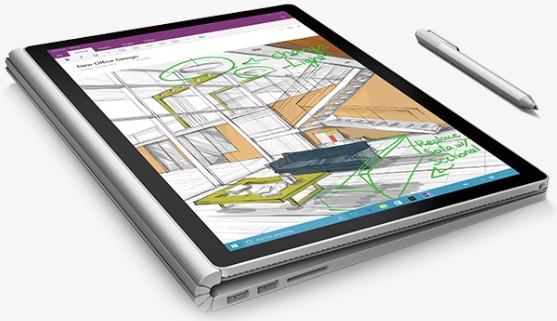 The 13-inch MacBook Air’s display remains at 128 ppi (pixels-per-inch) where it’s been for nearly five years, while even the new MacBook’s Retina display is 226 ppi. In contrast, the Surface Book’s 3000 x 2000 pixel display clocks in at a razor sharp 267 ppi. Even the machined aluminum case the MacBook Air made popular (inspiring countless Ultrabooks) is targeted with the Surface Book’s Magnesium alloy case which, Microsoft points out, is lighter and more durable than aluminum. The whole thing comes in at just 1.6kg, with the display/tablet on its own weighing only 768g. Battery life is competitive, at 12 hours on a charge.
The 13-inch MacBook Air’s display remains at 128 ppi (pixels-per-inch) where it’s been for nearly five years, while even the new MacBook’s Retina display is 226 ppi. In contrast, the Surface Book’s 3000 x 2000 pixel display clocks in at a razor sharp 267 ppi. Even the machined aluminum case the MacBook Air made popular (inspiring countless Ultrabooks) is targeted with the Surface Book’s Magnesium alloy case which, Microsoft points out, is lighter and more durable than aluminum. The whole thing comes in at just 1.6kg, with the display/tablet on its own weighing only 768g. Battery life is competitive, at 12 hours on a charge.
From any angle, this is a very attractive-looking piece of gear.
And of course, the Surface Book has the un-matched advantages of touchscreen support and the ability to ditch the bulk and transform into a tablet. It’s no wonder Microsoft is billing it as the “Ultimate Laptop.”
With the Surface Book—its first laptop—Microsoft has made a statement. Windows 10 has seriously upgraded the PC experience for over 110 million users (to date) and now the company has designed the ultimate hardware to run it on. The Surface Book offers performance, a premium design and an innovative new take on 2-in-1 laptops that is going to shake up the status quo.
You can pre-order the new computers from Microsoft, including the Surface Book, from Best Buy

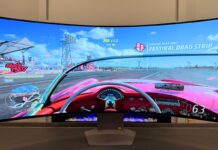
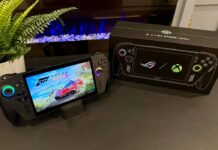
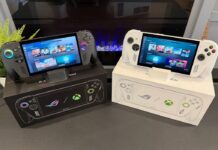
When Panay rolled the second video during the demo, many people were utterly surprised, if not shocked.
Comments are closed.